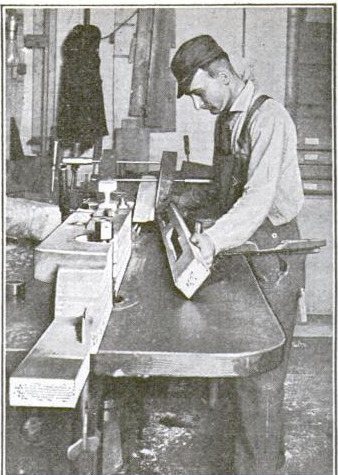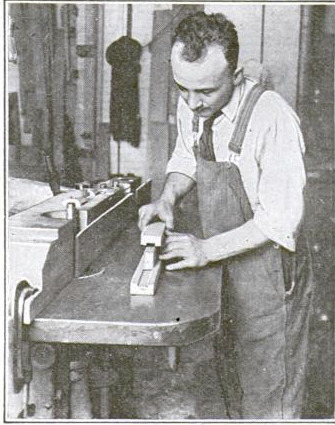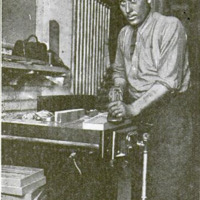The warping of aircraft propellers and how it is prevented
Contenuto
-
Titolo
-
The warping of aircraft propellers and how it is prevented
-
Article Title and/or Image Caption
-
Title: Stopping the Ariplane Propeller from Drinking Too Much
-
extracted text
-
DURING the war one of the great-
est troubles experienced with air-
plane propellers was the warping and
twisting of the blades near the tips,
and a large percentage of the propellers
received at the front were rejected on
this account.
In order to determine the causes and
to develop methods of preventing this
trouble, a number of experimental
propellers were manufactured for the
War and Navy Departments by the
Forest Products Laboratory of the
U. S. Forest Service, at Madison,
Wisconsin.
The propellers were made of Central
American and African mahogany, the
wood being carefully selected stock,
uniform in density and moisture con-
tent. They were stored under uni-
form atmospheric conditions for thirty
days between the roughing out and
final carving operations. After the
standard finish, consisting of five coats
of spar varnish, had been applied, they
were again stored under the same
conditions for observation us to warp-
ing and twisting.
Humidity Is the Bugbear
These propellers were made up and
handled much more carefully than the
commercial product, and every pos-
sible effort made to produce perfect
results. After exposure to a very
damp or humid atmosphere for three
or four months, it was found
that every propeller had
warped or twisted, or other-
wise changed shape, to an
extent that made them unac-
ceptable for use. They had
all absorbed about five per
cent of moisture through the
five coats of spar varnish, and
this moisture caused trouble.
The treatment to which these pro-
pellers were subjected, namely, being
manufactured under relatively dry
conditions and later exposed to moist
atmosphere, is very similar to that
which is normally received by pro-
pellers made in the United States and
shipped to France. Frequently pro-
pellers are made in a moist climate and
shipped to a drier one, and trouble
from change of shape due to drying
out, and consequent warping of the
wood, is almost sure to result.
“There are only two ways in which
trouble from change of shape due to
atmospheric conditions may be ob-
viated either make the propeller im-
mune from changes in humidity, or
keep it under the same atmospheric
conditions all its life. The experi-
ments just outlined show that it is im-
possible, even under ideal manufactur-
ing conditions, to produce propellers
that, if preventive measures are not
taken, will not warp or twist with
changes in moisture.
These changes may be prevented by
applying a moisture-proof coating.
At present, the aluminum leaf coating,
developed by the Forest Products
Laboratory, is the only practical
moisture-proof coating that has been
successfully applied to propellers. It
is not possible to keep propellers under
absolutely uniform atmospheric condi-
tions during manufacture and service,
but these conditions can be approached
by making up the propellers at the
moisture content which they will nor-
mally reach in service. Propellers
made up in this way and coated with
aluminum leaf, have the best possible
chance to give high efficiency and long
service.
Testing the Propeller’s Strength
The wood of which the propeller is
made is always tested for strength. In
doing this the machine shown in the
diagrams used. The strut is put under
pressure and the load increased grad-
ually till the maximum is reached—
that is, until the load ceases to increase
deflection. Repeated experiments on
Sitka spruce and Douglas fir airplane
struts of various patterns have shown
that if stopped at this joint
the test does mot injure the
strut. The sketch illustrates
a simple machine by which
struts may be tested in this
way at the rate of one hun-
dred or more an hour.
After the experimental
beams have been constructed
in the carpenter shop of
the Forest Products Laboratory
they are delivered by truck to one of
the testing laboratories for a final
strength test. One of these beams is
show... undergoing test. The load is
applied at four points through the
lever system which is attached to the
cross-head of the testing machine.
‘The two screws are turned by means of
gearing, thus drawing down the ross-
head through which they are threaded.
When a beam breaks it sometimes
shatters in a number of pieces and is
very apt to fly entirely out of the
testing machine. A broken beam is
shown in the foreground.
This particular machine was bor-
rowed from the Kansas State Agri
cultural College for the war emergency,
it being impossible to purchase a suffi-
cient number of machines from the
manufacturers. The results of many
tests indicate that the three-piece I-
‘beam is, under ordinary circumstances,
t0 all intents and purposes as strong
as, or even superior to, the solid I-beam
shaped out of one piece.
-
Autore secondario
-
Fred Gilman Jopp (Article writer)
-
Lingua
-
eng
-
Data di rilascio
-
1919-12
-
pagine
-
92, 94
-
Diritti
-
Public domain (Google digitized)
-
Archived by
-
Davide Donà
-
Marco Bortolami (editor)









